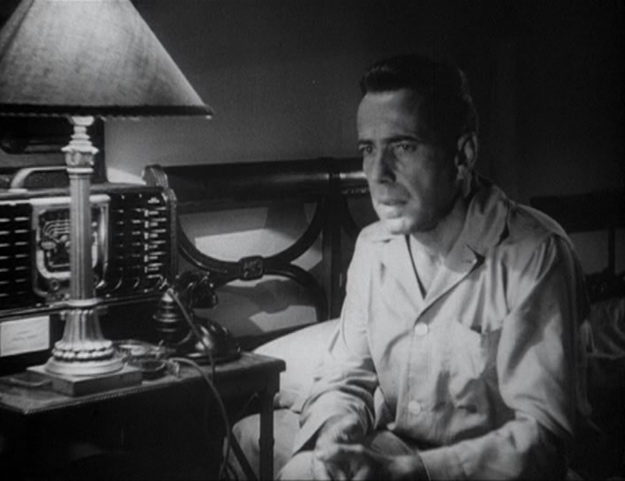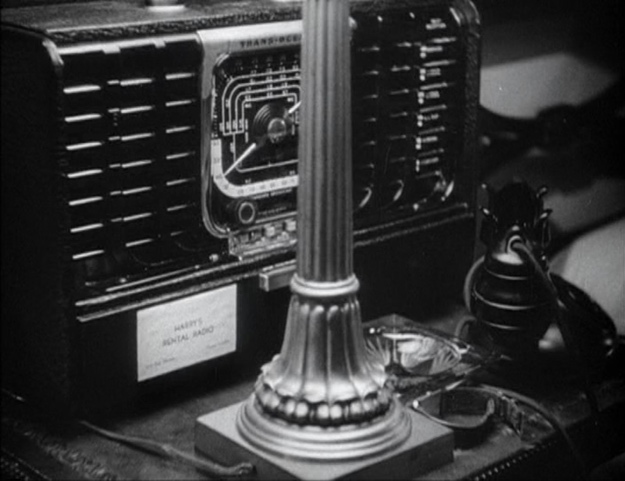Many thanks to SWLing Post contributor, Mark Hirst, who writes:
I’m something of a Film Noir fan, so I was pleased to have tracked down “Dead Reckoning” on Amazon recently.
Starring Humphrey Bogart and Lizabeth Scott, Bogart’s character is seen early on in this 1947 film listening to police chatter on his bed side radio.
The police conversation sounds a bit contrived, serving the purpose of advancing the story of course, though I’m wondering if this type of radio could be used this way – I’m sure there are experts who would know.
Please comment if you can answer Mark’s question!
Thanks for sharing, Mark. Like you, I love Film Noir and pretty much anything starring Bogie (or especially Lauren Bacall)!



The radio is an 8G005. First, the G500 didn’t come out until 1949, the movie was 1947. The bottom front of the 8G005 is larger as it has space for a log. Finally, the fold up front of the G500 has a gold emblem which reads “Royalty of Radio”. I have a G500, the 8G005 is an operationally identical radio.
In the original operating guide I have for the radio, it lists the G500 bands (same as 8G005) as follows:
Broadcast 535 to 1620 kilocycles
49m 6.0 to 6.2 megacycles
31m 9.45 to 9.75 megacycles
25m 11.5 to 12.1 megacycles
19m 14.9 to 15.5 megacycles
16m 17.5 to 18.1 megacycles
I also own a 1936 Emerson AR-176, On the dial between 1600-1700 kilocycles it is marked “Police”. I am thinking it is unlikely that the Trans Oceanic picture actually picked up police calls. The operating guide references shortwave reception, details the 50,000 watt clear channel stations, but makes no mention of police bands. I own a half dozen Trans-Oceanics and a couple publications about them. I have also read numerous articles about them, I don’t recall a single reference to police calls on the 8G005/G500.
Nice find of the radio in the movie!
Scott Gambel’s link above shows LAPD still using 1700 Khz in 1964. I remember monitoring this transmitter in ’65 both from Colorado and LA. It was not a repeater for mobile units and seemed to be a legacy dispatch simulcast.
Another great Bogart movie, The Caine Mutiny, had many memorable scenes in the ship’s wardroom with a communications radio prominently displayed on a shelf in back. I don’t have a screen shot, but possibly other film addicts recall the scenes and can identify that radio.
In an episode of MASH Hawkeye and BJ order one from the Sears-Roebuck catalogue, which ends up driving Charles crazy.
Sounds plausible I recall, when I was very young my grandmother had an 02CP Crosley radio tuned around 2Mhz. This was the police frequency in the late 1950’s, Later she could not pick up the police (likely going to VHF. Anyone have historical radio frequency allocation charts?
The radio featured in Dead Reckoning appears to be a Zenith Trans-Oceanic G500.
My Philco radio model 42-350 dates from 1942. The high end of the standard broadcast band from 1600 – 1720 kHz is marked on the tuning dial as POLICE .
I don’t know if the standard broadcast band on postwar Trans-Oceanic models will tune much higher than the marked 1600 kHz. My later Trans-Oceanic H500 (1951) and B600 models will not. The H500 and 600 series feature a 2 – 4 MHz band that will tune below the marked 2.0 MHz to at least 1550 kHz. The postwar G500 does not feature the 2 – 4 MHz band.
Interestingly, the dial position of the Trans-Oceanic shown in the photo from Dead Reckoning is not correct if the radio is tuned to 1600 – 1720 kHz.
The AM broadcast band used to stop at 1610KHz. Going up to 1710 is new, at least thirty years. So that range woukd provide reception “just above the broadcast band”.
I did a little more snooping. The radio featured in Dead Reckoning is indeed the Trans-Oceanic model 8G005Y which is very similar in appearance to the G500. The first 8G005Y radios were sold in 1946 which was the year Dead Reckoning was filmed. Somebody wanted the coolest radio they could get their hands on for this movie.
What I find interesting is the card on the lower let of the radio “Harry’s Rental Radio.” Looks like there
may be a phone number on the card.
I wonder if this was a purposeful prop on the radio. For example, maybe the film company thought that the hotel would rent their radios from someone and placed the card on it as a prop.
Or did the film company rent an actual radio (or radio prop) from Harry’s and just forgot to remove the card. Does anyone know if there is (or was) a Hollywood Rental company called Harry’s.
Bill
WD9EQD
Smithville, NJ
People in the antique radio forum sometimes mention being asked to rent a radio as a prop. Undoubtedly there are places now that rent radios among their other props.
It seems a bit odd that far back, radios were common, and I thought the movie studios tended to keepthings just in case. (That changed starting around 1970 when tge value if land rose so it was too tempting to not sell off the backlots, and maybe old props in storage.
Michael
One-way police broadcasts began in the 1920s, and since these early experiments used what is now our AM broadcast band, could have been picked up on the Trans-Oceanic. It wasn’t until the mid-30s that two-way communications between police stations and cars began. I’m not sure when Dead Reckoning was supposed to be set, but its 1947 release date wasn’t long after it was feasible to hear police transmissions in this way.
No affiliation to the site, but there is an interesting chronology of police radio at: http://rfpd.tripod.com/id18.html
Looks like it’s either a G500 or an 8G005 model
https://people.ohio.edu/postr/bapix/Zn_G500.htm
https://people.ohio.edu/postr/bapix/ZTO_8G005.htm
if so, the bands coverage, according to some sparse infos I found should have been
540 – 1600 KHz
2 – 4 MHz
4 – 8 MHz
9.4 – 9.8 MHz
17.5 – 18.1 MHz
14.9 – 15.5 MHz
11.6 – 12.0 MHz
now, as for the ability to receive police radio, it depends from which frequencies the police used at the time
Before WWII early police use of radio was just above the AM broadcast band. I don’t know when it started, or ended. It was initially one way, the transmitter at a fixed location. So messages could be sent out, but the cops in patrol cars had to find a callbox to reply.
I’ve read that for a while some table radios including the band specifivally so people could listen in. Obviously a Transoceanic as a shortwave radio would cover the frequencies.
There was aBugs Bunny cartoon where two guys rob a bank and hideout, and they listen to police broadcasts on a table radio.
I suspect “caling all cars” dates from that era, coming unto public consciousness and remaining after tye police moved to higher frequencies and two way radio.
Even uf this mivie came after the move, it wouldn’t have been too much of a stretch.
Michael
Police calls used to be on shortwave and could be monitored by anyone with a radio capable of receiving shortwave broadcasts, such as the Zenith in the movie. In the 1960s, I frequently listened to Phoenix and Los Angeles police calls on my Hallicrafters S-38E receiver.